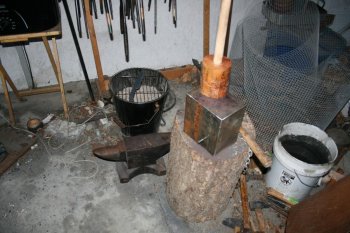Doug Lester
Well-Known Member

Above is my new(ist) anvil. It's an 87lb block of H13 that I purchased from a steel warehouse that was selling it's cut-offs on Ebay. The deminsions are 8.25X7.25X4.25". I was a little worried when I got it because it seemed a little soft and didn't have a ring. I'm sure my neighbors don't mind that last part, though. It's rebound wasn't all that bad but not quite as much as the 110lb anvil that's now sitting on the floor to be used as an upsetting block.
I knocked off the sharp edges with my angle grinder this afternoon and decided to start a new kitchen knife that I had planned. I couldn't believe how much faster I moved metal with the new anvil. I thought that I would only have enough time to forge out the tang before it got dark but I got the whole thing forged, straightened, and normalized to relieve stress. Looking at the 110lb anvil I realised that if I took off the horn, the heal, and the feet I probably wouldn't have much over 50lbs left.
I have a 30 kilo anvil that holds my hardy tools and if I need a horn I can use it.
Doug

